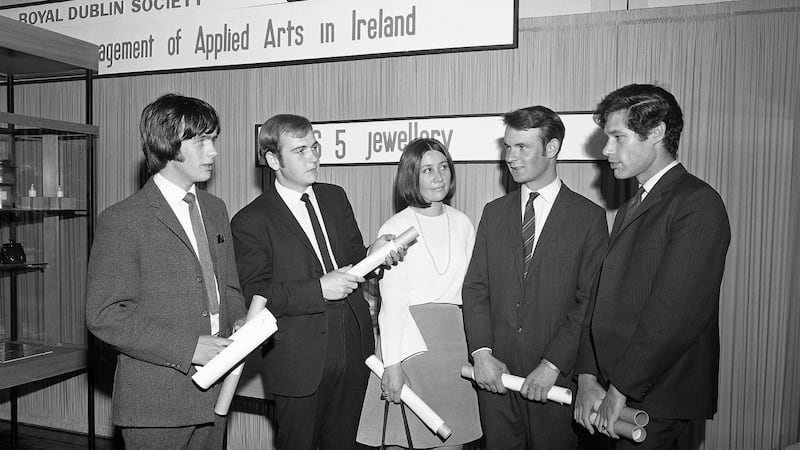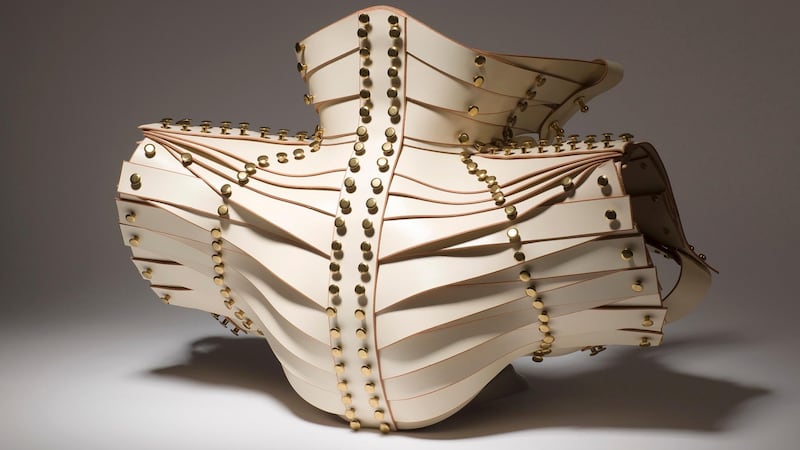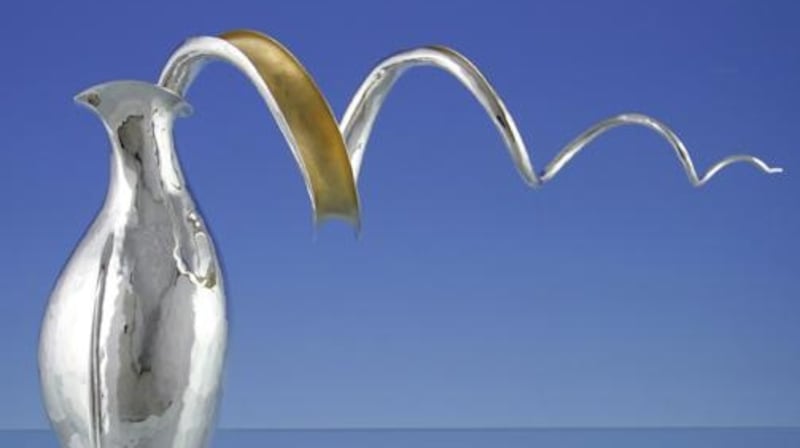There's a story told in The Maker's Hand, an exhibition celebrating 50 years of the RDS Craft Awards that encapsulates so much of the heritage, prestige – and the fun – of the annual show.
It was 1980 and Keith Leadbetter of Jerpoint Glass had just been awarded the California Medal – the top prize in an exhibition that had as many as 18 categories and many smaller awards.
The medal was so called because in 1889 the Royal Dublin Society received a letter from a bank in San Francisco telling it that $880 dollars had been deposited in the bank to be used to support artists in Ireland – and the idea of a gold medal was born.
His six glass goblets (which later went on to become a commercially successful product for the Kilkenny glass maker) were sitting on a plinth in a Perspex display case. As the awards evening wore on, empty wine glasses were deposited on the case and then someone tipped the whole lot over.
As Kathleen Leadbetter tells it, in one of the lively and informative panels that form the backdrop of the celebratory exhibition, as the wine glasses smashed and the room went silent and breaths were held, the six Jerpoint glass goblets rolled on the floor and survived without a chip.
For The Maker's Hand, curators Dr Anna Moran, a senior lecturer in NCAD and a design historian, and exhibition designer Wendy Williams had the task of reflecting a half century of the country's most prestigious craft awards show.
They chose 40 objects ranging from wrought iron to Carrickmacross lace, leatherwork to musical instruments, pottery to furniture.

“It wasn’t about looking at each year. We wanted represent each material and the range of crafts and awards,” says Moran.
It was a massive task – not least because a unique aspect of the RDS Craft Awards show was that it was open to both professional and amateur makers. Would-be exhibitors typically worked on a special one-off piece for submission to the selection committee, and often, especially if it had won an award, the piece was sold. So for Moran and Williams it was a case of chasing objects and persuading many private collectors to loan the work for the duration of the show.
“That’s a really interesting thing about this exhibition, it’s not pristine. Many of the objects on show have been used, there’s a history there,” says Moran, citing as examples a saddle, and a priest’s vestments (made by Rita Scannell which won for its embroidery and is in a Washington parish) which are in use by their owners.
Revealing the cultural breadth of the RDS awards, a beautifully embroidered bride’s veil from the 1960s by Kathleen Flanagan is shown alongside Úna Burke’s 2013 leather sculptural bodypiece (her clients include Lady Gaga and Rihanna).

When the annual exhibition began in 1968 there were 150 entries; by 2017 that had grown to 336 – a sign of the good health of the craft sector. Makers submitted work anonymously and the peer aspect of the awards centred on the judging process which saw specialists – often international experts – judging each class. The exhibitions were catalogued creating a valuable half-century archive documenting the changing state of the craft sector in Ireland.
The research also involved interviewing past participants: “It was poignant really, to see how important the exhibition was to the makers. It wasn’t about prizes for most, it was about the recognition of their peers. Exhibiting gave them confidence, it kept many going,” she says.
Horse Show
Each year the RDS Craft Awards, with about 100 exhibits, took place over five days to coincide with the Dublin Horse Show, so for makers there was the exposure of being part of a well-attended, high-profile annual exhibition. It also helped keep some crafts alive; Moran mentions lacemakers in particular as craftmakers whose work benefited from the exposure.
The Dublin Horse Show link was important too, says Moran, “it opened up craft to a new audience, it was a shop window for the exhibitors”. Visitors over the years also had the chance to see work being made as potters and weavers set up their equipment and gave demonstrations.
The Maker's Hand exhibition also celebrates some of the enthusiasts – often volunteers - whose energy and input helped keep traditional crafts alive in the 20th century, and the standards of the RDS awards high.

Once such was Donegal woman Muriel Gahan, who in 1930 set up the Country Shop on St Stephen’s Green as a showcase for Irish craft – a “non-profit craft depot” as Moran describes it – who for decades was a driving force in the awards, while also touring the county promoting traditional crafts and holding small exhibitions.
“She looked closely at the classes [categories] of craft that needed support or ones that looked like growing based on the number of submissions received,” says Moran.
“In the 1970s, for example, Muriel wanted to promote and encourage the traditional tin and copper work made by the Travelling community so she created an awards category for that.”
Asked to pick her favourite piece of the 40 gathered for the show, Moran cites the “Donovan Chalice”, the winner of the California Medal at the first exhibition in 1968 – not least because it shows the opportunity and encouragement the exhibition afforded makers.
Peter Donovan was at the time a young silversmith making pieces created by the designers at the Kilkenny Design Workshop. For the exhibition he made a piece to his own design – the chalice – and submitted it for possible inclusion. Winning the medal, says Moran, gave him the confidence and contacts to set up his own – successful – silversmith business.
“What we saw as we researched the awards was that they encouraged makers to work outside what they would normally be doing.”
End of an era
As well as being a retrospective The Maker's Hand marks the end of an era – the RDS will no longer host an annual craft exhibition.
From the mid-18th century the organisation, in keeping with its philanthropic mission to encourage and develop “native industry”, awarded prizes to craftspeople.

There was an annual crafts exhibition to coincide with the Dublin Horse Show from 1904, when the new Arts Industries Hall opened, to 1921. So when the 1968 exhibition opened, it was building on a long tradition. The new plan based on a bursary system sees the RDS continuing to support craftmakers through partnership with the Design & Crafts Council of Ireland (see panel) but for hundreds of makers, particularly those working in craft areas considered more niche or uncommercial, the chance to exhibit annually in a major prestigious venue, where a crowd was guaranteed and which came with the opportunity of being judged by your peers has, after 50 years, come to an end.
The Maker’s Hand: Fifty Years of the RDS Craft Awards, Thursday June 21st- Friday August 17th. RDS Library. rds.ie
Bursaries replace annual awards
In place of the annual RDS Craft Awards exhibition, the RDS has, it says, “restructured” its support of crafts by partnering with the Design & Crafts Council of Ireland’s (DCCoI) Future Makers programme.
The RDS will fund five annual bursaries of €10,000 each to be awarded to five makers who have already successfully made it on to the DCCoI Future Makers programme in the previous year (2017 Future Makers – about 25 of them – will be eligible to apply for the 2018 RDS bursaries, and so on). A panel of six judges commissioned by the RDS will decide the awards which will be announced on June 20th. There is a further €10,000 annual bursary from the RDS for an established maker which will be managed by the DCCoI.
According to the RDS, the bursary system “will also be more aligned with the RDS arts work programme and its goal of supporting artists to make the transition from emerging to professional practice”.
The amounts of money are substantial and will undoubtedly prove a significant and meaningful support for the six recipients. For hundreds of other craftmakers though, particularly those at the point in their careers who don’t consider themselves “emerging makers”; those working in traditional forms with limited commercial potential; gifted amateurs; or others whose business depended on the public exposure of the thousands of people who saw their work during Dublin Horse Show week, the new arrangement will prove a blow.

















